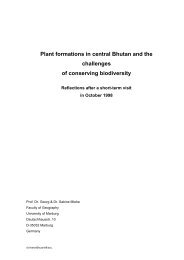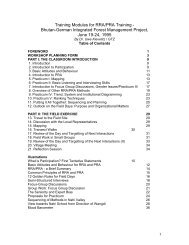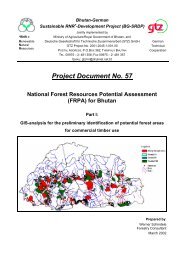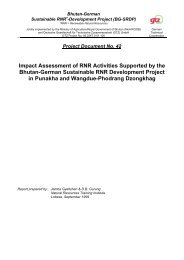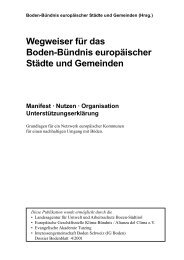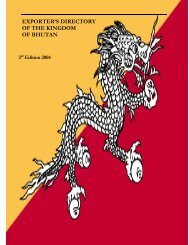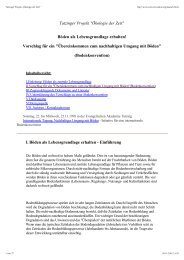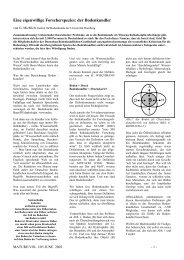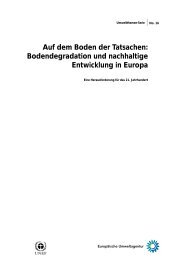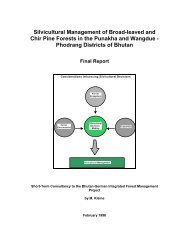GTZ Project Document No. 51 Report on Nahi Baseline Survey
GTZ Project Document No. 51 Report on Nahi Baseline Survey
GTZ Project Document No. 51 Report on Nahi Baseline Survey
You also want an ePaper? Increase the reach of your titles
YUMPU automatically turns print PDFs into web optimized ePapers that Google loves.
<strong>Nahi</strong> Approach Road of Hope RRA <strong>Survey</strong> May 2001with different subjects under different c<strong>on</strong>diti<strong>on</strong>s should provide guidance <strong>on</strong> whether notes should betaken.Appropriate locati<strong>on</strong>s for interviews. As a general rule interview should be c<strong>on</strong>ducted under c<strong>on</strong>diti<strong>on</strong>smost relevant to and revealing about the local system being investigated. For example for agriculture,wherever possible, interviews should be carried out in farmers’ fields with visible evidence of farmers’management before the rapid Appraisal Team. The Rapid Appraisal Team should always note whereinterviews are c<strong>on</strong>ducted.8. USE OF DIRECT OBSERVATIONDirect observati<strong>on</strong> is an important Rapid Appraisal tool that can be used to validate data collecti<strong>on</strong> inadvance, provide multiple checks <strong>on</strong> data collected from interviews, and suggest additi<strong>on</strong>al topics forinterviews. Direct observati<strong>on</strong> of “key indicators” often provides more valid and less costly informati<strong>on</strong>than other research methods. Examples of key indicators would be like; soil colour to indicate particlesize distributi<strong>on</strong>; fertility, and drainage properties, birth weight of children to indicate health andnutriti<strong>on</strong> in an area, housing to indicate poverty to prosperity, farm tools and implements, cattle breeds,forest coverage, drinking water facilities, etc.Direct observati<strong>on</strong> can be as important as interviews for Rapid Appraisal. Thus the Rapid Appraisalteam is encouraged to use special techniques that can improve direct observati<strong>on</strong> such as: “keyindicators” as proxy measures ad cameras. Finally, to improve observati<strong>on</strong>al skills, the Rapid Appraisalteam is encouraged to maintain carefully written field notes.9. PREPARATION OF REPORTRapid Appraisal is not complete until the report is finished. The team members are usually assigned acertain porti<strong>on</strong> of the report to be written at the end of the survey. Each member drafts and reads thepart written by him for group discussi<strong>on</strong>. In the process the team approves or modifies the individualsecti<strong>on</strong>s of the report. Even additi<strong>on</strong>al trips and interview if necessary are made for colleting themissing informati<strong>on</strong>. The individual secti<strong>on</strong>s of the report are reread to the group and therecommendati<strong>on</strong>s from the team are then recorded. As the report will be rewritten later, in the field theteam should not worry too much about grammar and style. It is important to get the informati<strong>on</strong> downwhile still fresh <strong>on</strong> every<strong>on</strong>e’s minds. The goal is to write a report that reflects interdisciplinary natureof Rapid Appraisal.10. GETTING RESULTS FACTORED INTO DECISIONSAccording to Chambers “good rapid appraisal will be bad rapid appraisal unless it leads to betterperformance”. Chamber makes three recommendati<strong>on</strong>s to increase the chances of Rapid Appraisalinfluencing decisi<strong>on</strong>s: Full involvement of project staff; Meshing with current programs includingbudget allocati<strong>on</strong>s, Priority to what can be d<strong>on</strong>e so<strong>on</strong>.The most important element in ensuring the use of the Rapid Appraisal results is not to let the report beshelved away “<strong>on</strong>ly to gather dust”. Rapid Appraisal should be the guide for the future and shouldc<strong>on</strong>stantly be upgraded as the activity progresses.POTENTIAL PROBLEMSIf Rapid Appraisal is to be a useful research tool, several pitfalls must be avoided. These include overreliance <strong>on</strong> the initial findings, too much focus <strong>on</strong> the Rapid Appraisal as an end in itself, insufficienttime and effort resulting in “Development Tourism”, failure to recognise the differences between rapidAppraisal and baseline study, and lack of agreement <strong>on</strong> what c<strong>on</strong>stitutes Rapid Appraisal resulting inserious questi<strong>on</strong>s about the c<strong>on</strong>fidence that can be placed in the data.DiagnosticismThe belief that a quickly d<strong>on</strong>e Rapid Appraisal at the outset of a project can provide a sufficiently validunderstanding of the situati<strong>on</strong> to serve as bases for all future interventi<strong>on</strong>s is dangerous. The RapidAppraisal is best used as a heuristic device to initiate additi<strong>on</strong>al formal studies and interventi<strong>on</strong>s.Inappropriate focusInvesting too much time and effort in Rapid Appraisal can delay a project. It can also c<strong>on</strong>fuse the usesof Rapid Appraisal as a tool and as an end product. Recognise the limits of Rapid Appraisal and it canxxiii



